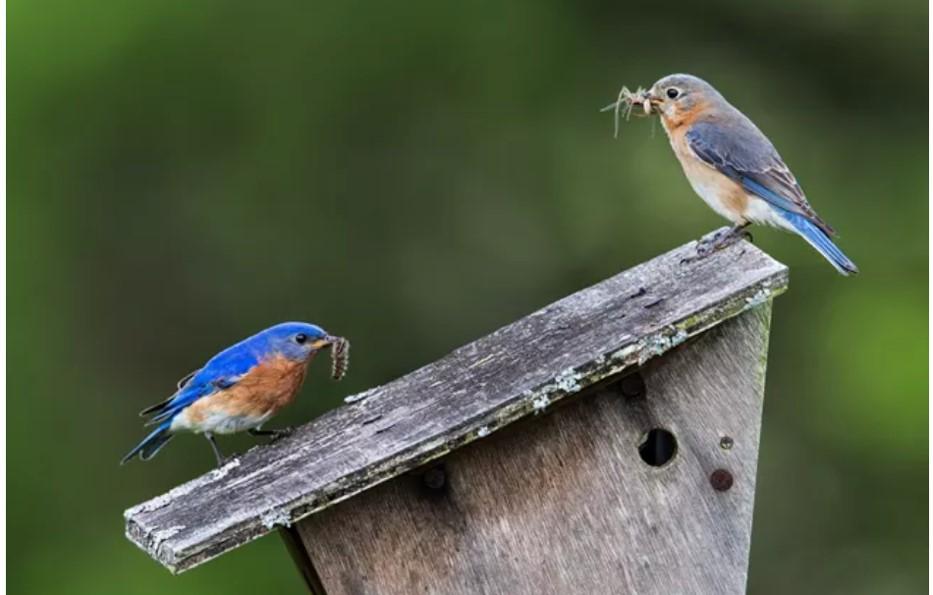How To Help Bluebirds

Green Committee - 3rd in a Series on Bluebirds
There are many ways you can help bluebirds and our other feathered residents. You may be actively out and about on the campus enjoying the birds at their nest boxes. You might stay closer to home and maintain a nearby feeder or bird bath. Maybe you watch from indoors and enjoy reading all about them. However, you are able to appreciate them, there is a way you can help.
Active Weekly Monitoring of Nest boxes
In my presentation on March 9th (recorded and available for viewing on the Touchtown Resident App, under Green Committee, Presentations),
I explained the importance of building a safe nest box, locating it in the correct place, and monitoring it weekly throughout the nesting season. This is the most hands-on way to help.
Feeders and Bird Baths
Bluebirds are insect and berry eaters not seed eaters, but they will come to a suet feeder. There are also specially designed bluebird feeders similar to the one pictured below. Look for one made from a durable wood like cedar, with a gently sloping roof, so you can sprinkle some dried mealworms and/or bluebird nuggets (both available locally at Tractor Supply) on the roof when you are teaching the birds how to find the food inside the box. Most backyard birds will not go inside to get food, which allows the bluebirds to enjoy the treats you have provided for them. You can buy open feeders for the mealworms and nuggets, but then you will be sharing these specialty foods with all the birds in your yard. They would love this of course, but you may not!
A note about mealworms. Dried mealworms are great to offer during the winter, but they should not be offered once nesting season begins. Nestlings get all their water from the insects they eat, so they need juicy caterpillars. Live mealworms can be offered in your feeders in limited amounts. You can find more information about the specifics on the North American Bluebird Society website (www.nabluebirdsociety.org) and read the Fact Sheet on mealworms.
Birds love a bath! In winter a heated bird bath can be a matter of survival when everything else is frozen. Avoid using the heaters that submerge in your concrete or ceramic summer bird bath, as they will ruin them. A plastic or metal bath would work better for this type of heater. If you are shopping for a bath with built-in heater, check out the ERVA brand. they are expensive, but they get excellent reviews for being durable and easy to clean. They can be on a mounting pole, a low tripod or rail mount. Another choice, still a little pricey, is one made of plastic with a built in heater. It also is available with a separate pedestal, low stand or rail mounting. Its a little tricky to put together at first, but is easy to clean with a brush.
Egg Shells
Many female birds eat the egg shells as soon as their chicks hatch to replenish their calcium supply. You can recycle your egg shells and help a mama bird have strong eggs of her own by rinsing them, letting them dry, putting them in the oven on low heat (200 degrees) for an hour. Put them in a plastic zipper bag, squeeze out the air and zip it closed, then crush the shells with a rolling pin or the back of a large spoon….or throw them in your blender. Mx them into the seed in your feeder or just toss them on the ground.
Natural Bird Food
According to author Doug Tallamy, in his New York Times Bestseller book, Nature's Best Hope, research shows that a pair of Carolina Chickadees need 6,000 to 9,000 caterpillars to raise one brood of nestlings. Imagine how many caterpillars it takes to raise all the different species of birds!
Birds need caterpillars. Caterpillars need native plants. If we can tuck some very important native plants (called Keystone plants) into our raised beds, flower beds and yards, it will make a big difference in the numbers of birds we have. Here are some places to find out more about native plants that work in our area.
Native Plants for Backyard - US Fish & Wildlife Service www.se-eppc.org
Keystone Plants Native Plant Finder by Zipcode https://www.nwf.org/
Plant Virginia Natives. plantvirginianatives.org
Some Local Sellers of Native Plants
THE NATURAL GARDEN - at Harrisonburg Farmers Market on Saturday mornings starting in April. Pre-order on-line for pick up at Market, or browse weekly selections there. They will also come to your house, make suggestions, and contract to do the planting for you.
https://www.thenaturalgarden.net
540-432-5522
FRIENDLY CITY CO-OP They sell native plants from The Natural Garden
150 E. Wolf Street, Harrisonburg
540-801-8882
GRASS ROOTS LANDSCAPING They carry some native plants, including blueberries
1084 Virginia Avenue, Harrisonburg
grassrootslandscapinginc.com
540-810-2410
HUMMINGBIRD HILL NATIVE PLANT NURSERY This nursery is absolutely serious about making sure their plants are sold to people who specifically want to counter habitat loss and create habitat corridors and you must meet their qualifications to buy from them! They will re-open by appointment in early April 2022.
hummingbirdhillnatives.com
4190 Free Union Rd, Charlottesville, VA 22901
hummingbirdhillnatives@gmail.com
Books to Enjoy
These books and magazines will soon be available in the Sunnyside Library.
Nature's Best Hope - Doug Tallamy
The Bluebird Monitor's Guide to Bluebirds and Other Small Cavity-Nesters
Cynthia Berger, et al
The Bluebird Effect - Uncommon Bonds with Common Birds
Julie Zickfoose
What Bluebirds Do (a children's book with beautiful photos)
Pamela F. Kirby
Bluebird magazine
North American Bluebird Society
Donations
Some folks have asked about making donations to help with costs of maintaining the trails. Donations are gratefully accepted as it is the only way The Bluebird Project receives money for needed materials. Make check payable to : The Bluebird Project. You may drop it off at mailbox #159 (Jim and Gail Fisher) in the Highlands building. Thank you!